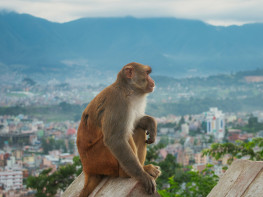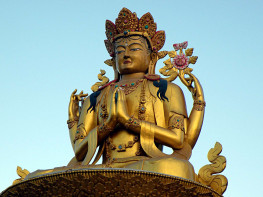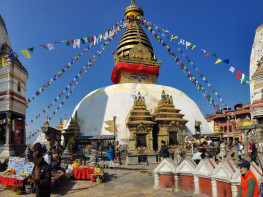
Swayambhunath
Swayambhunath, also known as the Monkey Temple, is an ancient religious complex located on a hilltop in Kathmandu, Nepal. This sacred site holds deep spiritual significance for both Buddhists and Hindus. The main attraction is the magnificent stupa adorned with colorful prayer flags and intricate carvings. Visitors can enjoy panoramic views of Kathmandu Valley, observe the playful monkeys that roam the area, spin prayer wheels, and soak in the serene and spiritual atmosphere of this iconic cultural and religious landmark.
| Name: | Swayambhunath |
| Country / District: | Nepal , Kathmandu |
| Full Address: | kathmandu, Nepal |
| Altitude: | 1350 meters |
| Special Attraction: | Swayambhunath's key attractions include the magnificent stupa adorned with intricate carvings, the panoramic views of Kathmandu Valley and the Himalayas, the playful monkey population, the spinning prayer wheels, and the colorful prayer flags that add a vibrant touch to this sacred Buddhist site in Nepal. |
Swayambhunath: A Sacred Beacon of Nepal's Spiritual and Cultural Heritage
Swayambhunath, also known as the Monkey Temple, is an ancient religious site located on a hilltop in Kathmandu, Nepal. It is one of the most sacred Buddhist sites in the country, revered for its spiritual significance, architectural splendor, and panoramic views.
Spiritual Significance
Swayambhunath is believed to be over 2,500 years old and is revered as a place of pilgrimage and meditation. The site holds deep spiritual significance for both Buddhists and Hindus. For Buddhists, Swayambhunath represents the primordial Buddha, Swayambhu, who is said to have emerged spontaneously from a lotus flower. For Hindus, Swayambhunath is associated with the god Vishnu, who is said to have taken the form of a monkey to protect the Kathmandu Valley from a demon.
Architectural Splendor
The main stupa of Swayambhunath is a magnificent architectural structure adorned with colorful prayer flags and intricate carvings. The white dome-shaped stupa represents the enlightened mind, while the painted eyes of the Buddha on all four sides symbolize the all-seeing wisdom. The stupa is surrounded by a number of smaller temples and shrines, each with its own unique significance.
Panoramic Views
Perched on a hilltop, Swayambhunath offers stunning panoramic views of Kathmandu Valley and the surrounding landscape. Visitors can climb the 365 steps to reach the top and be rewarded with breathtaking vistas of the city, with the Himalayan mountains visible on clear days.
Monkeys and Wildlife
Swayambhunath is known for its resident monkey population, hence its popular nickname, the Monkey Temple. The monkeys freely roam around the site, adding a lively and playful element to the experience. The area also attracts various bird species, making it a birdwatching haven.
Prayer Wheels and Prayer Flags
The complex of Swayambhunath consists of numerous prayer wheels that visitors can spin clockwise, symbolizing the recitation of prayers. Colorful prayer flags flutter in the wind, carrying prayers and blessings to the world.
Cultural and Historical Importance
Swayambhunath has witnessed centuries of history, surviving earthquakes and changes over time. It is a testament to Nepal's rich cultural heritage and serves as a reminder of the country's deep-rooted religious traditions.
Pilgrimage Site and Cultural Tourism
Swayambhunath attracts pilgrims and tourists from around the world who come to seek blessings, meditate, and explore the spiritual ambiance of the site. It is also a popular tourist destination due to its cultural significance, architectural beauty, and panoramic views.
Visiting Swayambhunath
Visiting Swayambhunath offers an opportunity to immerse oneself in Nepal's spiritual and cultural heritage. The peaceful atmosphere, stunning vistas, and the playful presence of monkeys make it a memorable and captivating experience for all who visit this iconic religious site.
Tips for Visiting Swayambhunath
- The best time to visit Swayambhunath is during the spring (March-May) or autumn (September-November) when the weather is mild.
- Be respectful of the religious and cultural significance of the site.
- Dress modestly, covering your shoulders and knees.
- Remove your shoes before entering the temples.
- Be aware of the monkeys and refrain from feeding them.
- Enjoy the stunning views and the peaceful atmosphere of this sacred site.
Conclusion
Swayambhunath is a truly unique and special place, offering a glimpse into the heart and soul of Nepal. It is a must-visit destination for anyone interested in experiencing the country's rich cultural heritage and spiritual traditions.


